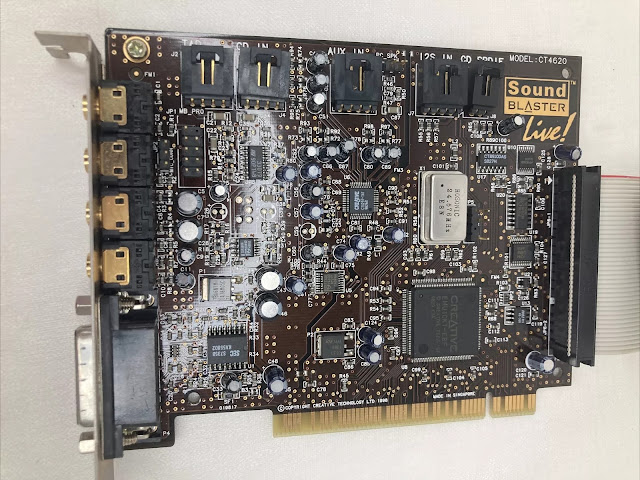The Nintendo 64 has had devices (such as the Bung Doctor V64) which allowed games to be played unofficially almost from its release. The 2010s saw the introduction of the first flash cartridges for the console such as the EverDrive 64. Flash cartridges have come a long way and now can run almost any regular N64 cartridge game. Until recently there was only one flash cart readily available, the EverDrive 64 X7, but now it faces competition from an open source flash cart, the SummerCart64, which promises new functionality. In this blog article I will take a look at the SummerCart64 and go over its functionality.
Thursday, September 26, 2024
Thursday, September 12, 2024
Sound Blaster Live! Primer
The Sound Blaster Live! represented Creative Labs return to products which could compete with other sound cards designed for the PCI Bus. First released in 1998, the Live! was Creative's first "real" PCI sound card. Things had changed, competing chipsets had improved in quality, Windows 95's standardization meant that sound drivers did not have to adhere to proprietary hardware as they did with DOS and the use of wholly-digital sound leveled the playing field compared to the DOS era. Let's explore their Live!
Tuesday, September 10, 2024
D&D and AD&D Character Creation Historical Overview
Dungeons and Dragons in all its forms and editions requires you to create one or more characters to play the game. The process by which this has been done has changed over the years, gradually increasing in complexity edition by edition. In this blog article today I would like to focus on how it changed during the first twenty-five years of the game's life.
Thursday, July 18, 2024
Tandy Deskmate - Tandy's Ace in the Hole
In 1984 Tandy released a software package called DeskMate. DeskMate was a basic suite of office productivity software and Tandy would bundle the software with its computers or sell it in Radio Shack stores and via mail order for a relatively low price. DeskMate, while little remembered today, was a key factor in putting Tandy computers in many homes. Let's take a look at how the suite did that and evolved over time.
Sunday, July 14, 2024
The Power of the Modern Gotek Floppy Drive Emulator
The Gotek Floppy Drive emulator is a diamond in the rough as it comes from the factory. While cheap, the common Goteks only emulate a single type of floppy. While this may be all you need if you only need a DOS or Windows 95 boot disk, running floppy disk images on vintage computers is quite possible with a Gotek flashed with community-based firmware. In this article I will take a look at what the Gotek can do with the Flash Floppy firmware.
Friday, July 12, 2024
Montech MKey - Dipping the Toe in the Modern Keyboard Scene
 |
| Montech MKey Full Size Darkness (Stock) |
My first post on this blog was about keyboards, namely the IBM Model M keyboard. At the time I thought it was the greatest keyboard that was ever made or will ever be made. As a mechanical buckling spring keyboard it was one increasingly few such keyboards that, even in reduced form through Unicomp, survived the push to cheap, disposable rubber dome membrane keyboards of the 1990s and 2000s. Mechanical keyboards have made a comeback with Cherry switches and their clones and advancements and improvements in keyboard design have compelled me to take a look and see if I can replace my beloved Model M as my desktop weapon of choice. Starting with a relatively inexpensive keyboard, the Montech MKey, let me explain in this blog entry the experience I have had customizing this keyboard.
Tuesday, July 9, 2024
Godzilla on Ultra HD 4K Blu-ray Disc
Tuesday, June 25, 2024
Nuked-SC55: True Roland SC-55 Emulation is Here
Roland Sound Canvas emulation has long been a "white whale" of DOS emulation. While there have been several efforts from Roland over the years to emulate the Sound Canvas line, they have not targeted the modules used by most DOS games, the SC-55 and SC-55mkII. Other emulation methods have not quite hit the mark for other reasons. Recently, an emulator author with the handle "nukeyt" has released an emulator called Nuked-SC55. In this article I will tell you how to run it with DOSBox and other programs.






